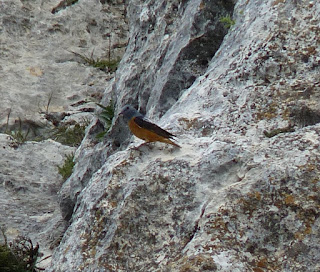Whilst I was exporing the Guadalhorce with US birding contact Mary Dokery, Dave and his Arboleas Birding Group were back up at the Sierra Maria and some good birds they turned, some of which would be year firsts for me. And judging from the photograph, Great Spotted Woodpeckers are easily tempted by a little white bread!
Sierra de Maria: Wednesday 30th May
Was
on my own travelling to the Sierra de Maria this morning. The sun was
out so I'd dressed in shorts and T-shirt. By the time I'd got to Maria
there were clouds in the sky and a chill in the air! As I waited for
the
others to arrive I watched the House Martins nesting in the forecourt
canopy of the town's Repsol Garage. I was joined by Barrie, Beryl,
John,
Brian, Mary and lastly Trevor and Ann. We drove up to the chapel car
park, seeing Magpie, Chaffinch and Collared Dove, but the star was a
Sparrowhawk. Following behind, Brian and Mary saw a Booted Eagle with a
pigeon breakfast! We parked up with two coach loads of school
children.
Also the local council were strimming the grass between the chapel and
the water fuente! It was agreed that we'd retreat and do the
plains before returning later. A Griffon Vulture or two glided
effortlessly over us. On the way down we met Jacky and Steve. They
decided to do the high walk, so we'd meet up later.
We
headed in convoy to the old farm buildings, seeing Jay, Blackbird and
Woodpigeon on the way. Arriving first I saw Rock Sparrow departing.
About three Hoopoes could be heard, Barrie also hearing a Woodlark call.
Brian spotted a Corn Bunting. I wandered round the buildings seeing
Goldfinch and more Rock Sparrows. Barn Swallows were in evidence and
John found a Red-rumped Swallow.
 |
| Short-toed Lark Calandrella brachydactyla (PHOTO: David Elliott_Binns) |
Moving on to the farm trough area, two Turtle Doves flew off as we arrived. Crested Lark and Rock Sparrows were seen. A
distant Booted Eagle was seen. We heard a bird calling from the
hillside behind us. I scanned the area and found one of the two Stone
Curlews seen. A first for us at Maria! I then found a male Northern
Wheatear near the sheep feeders. A Hoopoe flew past.
We
left there and drove slowly along the plain. In the leading car, I saw
only Crested Larks at first, but then found a pair of Short-toed Larks. A
pair of Red-billed Chough flew off as we passed. I spotted our only
Common Swift of the day. Calandra Larks were battling it out above the
foot long wheat stems. At the hamlet we saw only two Lesser Kestrels. On
the way back I spotted a Yellow Wagtail, but missed the Short-toed
Eagle and Griffon Vultures the others saw! Brian also had a Raven.
We
returned to the chapel area where the council gang were now painting
walls. A lot of work had been done. They had refurbished the water
trough and the BBQ area had been removed. Walking up towards the
Information Centre, a Melodious Warbler was singing from a shrub top as
was a Stonechat a bit further up.
We also had a Serin. At the Centre the
kids were in the building, so we sneaked into the gardens. Nothing near
the pools ( due to the noise?) but we did manage to see a few Bonelli's
Warblers as we joined the lower walk. We met up with Jacky and Steve
on their way down. They'd seen Crested, Blue and Coal Tits plus a
Subalpine Warbler. A female Crossbill showed well. Barrie heard a
Firecrest and we were lucky enough to get some brief glimpses of a few
of them. We passed the kids as we approached the gardens. A Subalpine
Warbler followed by a Rock Bunting and Bonelli's Warbler took
advantage of the relative silence to get a drink.
 |
| Male Stonechat Saxicolatorquatus (PHOTO: David Elliott_Binns) |
 |
| Melodious Warbler Hippolais polyglotta (PHOTO: David Elliott_Binns) |
We
then went for lunch at the La Piza forest cafe. As we enjoyed our snack
Chaffinch, Blue, Great, Coal and Crested Tits came to the bird
feeders. We saw a Iberian Green Woodpecker, Mistle Thrush, Jay and a
Sparrowhawk the far side of the track. A female Greater Spotted
Woodpecker came to the discarded bread rolls. On the way back to Velez
Blanco I added a White Wagtail and had a positive sighting of a
Woodlark.
 |
| Female Great Spotted Woodpecker Dendrocopos major (PHOTO: David Elliott_Binns) |
All in all we had a great day. 48 species. Great company, bit chilly though!
Regards, Dave
Check out the accompanying website at http://www.birdingaxarquia.weebly.com for the latest sightings, photographs and additional information







































